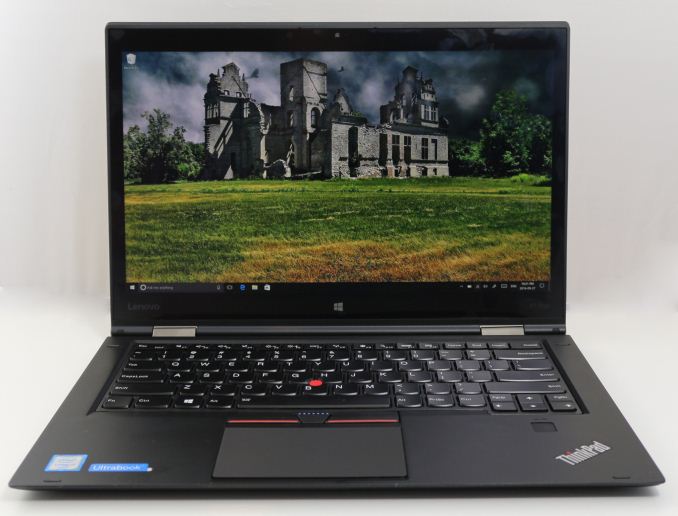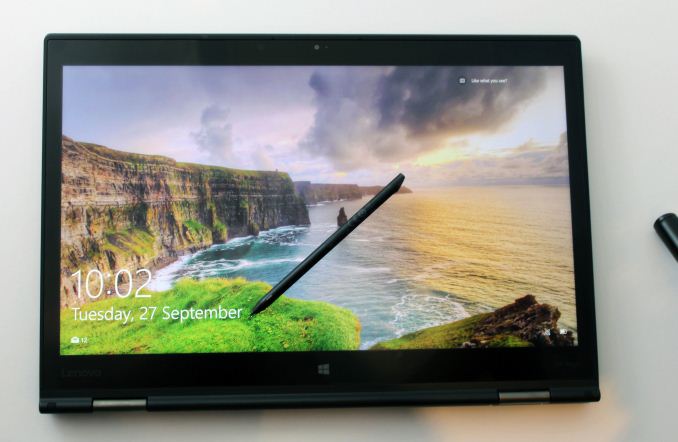The Lenovo ThinkPad X1 Yoga Review: OLED and LCD Tested
by Brett Howse & Brandon Chester on September 29, 2016 11:30 AM EST
Earlier this year at CES, Lenovo took the wraps off their latest lineup of premium business class notebooks, and they revamped the X1 lineup completely. Originally the X1 was just the X1 Carbon notebook, but Lenovo has decided to expand the X1 series to include the aforementioned X1 Carbon, along with the X1 Yoga and X1 Tablet. So the ThinkPad Yoga is now the ThinkPad X1 Yoga, and as such it keeps the same thin and light design of the X1 Carbon.
The Lenovo ThinkPad X1 Yoga Review
Thin and light is the key here, and the X1 Yoga doesn’t disappoint. The X1 Yoga is only 16.8 mm (0.66”) thick, and weighs 1270 grams (2.8 lbs). While not the thinnest and lightest notebook around, don’t forget that the X1 Yoga also features a 360° hinge, allowing it to be used exclusively with touch with several modes, including tablet, stand, and tent, just like the other Yoga devices they sell. Lenovo also pointed out that the X1 Yoga is thinner and lighter than the original X1 Carbon even, despite including touch and the convertible hinges.
Lenovo is offering plenty of choices here to outfit the X1 Yoga, with the baseline offering of an Intel Core i5-6200U and 8 GB of LPDDR3-1866. You can upgrade to the i5-6300U, i7-6500U, and i7-6600U, with RAM offerings up to 16 GB. On storage Lenovo has gone all NVMe, with choices from 128 GB to 512 GB. On the display side, the 14-inch panel can be either a 1920x1080 IPS, 2560x1440 IPS, or a 2560x1440 OLED model.
| Lenovo ThinkPad X1 Yoga | |||||
| As Tested: Core i7-6500U, 8GB, 512GB, 2560x1440 LCD | |||||
| CPU | Intel Core i5-6200U Dual-Core with Hyperthreading 2.3-2.8 GHz, 3MB Cache, 15W TDP Intel Core i5-6300U Dual-Core with Hyperthreading 2.4-3.0 GHz, 3MB Cache, 15W TDP Intel Core i7-6500U Dual-Core with Hyperthreading 2.5-3.1 GHz, 4MB Cache, 15W TDP Intel Core i7-6600U Dual-Core with Hyperthreading 2.6-3.4 GHz, 4MB Cache, 15W TDP |
||||
| GPU | Intel HD 520 300-1050MHz, 24 EUs |
||||
| Memory | 8GB to 16GB LPDDR3-1866 Dual-channel | ||||
| Display | 14-inch 1920x1080 IPS Optional 2560x1440 IPS Optional 2560x1440 OLED |
||||
| Storage | 128GB to 1TB SSD, PCIe and SATA | ||||
| I/O | OneLink+ USB 3.0 Type-A x 3 Headset jack 720p Webcam Mini DisplayPort microSD |
||||
| Dimensions | 333 x 229 x 16.8 mm 13.11 x 9.01 x 0.66 inches |
||||
| Weight | 1.27 kg / 2.8 lbs | ||||
| Battery | 52 Wh, 65 W AC Adapter | ||||
| Keyboard | Spill-Resistant with TrackPoint | ||||
| Wireless | Intel Dual Band Wireless-AC8260 2x2:2 with Bluetooth 4.1 |
||||
| Price | Starting at $1400, as tested $1871.10 | ||||
Lenovo also offers plenty of connectivity on the X1 Yoga, including three USB 3.0 ports, HDMI, DisplayPort, and a OneLink connector for its docking stations. There are no USB Type-C ports, but the X1 Yoga does have MicroSD support for additional storage, and LTE-A as an option for those that want to be as untethered as possible. Wireless is supplied via the Intel 8260 wireless card, and as a business focused device it can be had with vPro as well.
They also include a stylus built into the laptop which will charge while docked. It’s not as big or as comfortable as the one included with something like the Surface Book, but the fact that it is docked will more than make up for that for a lot of people, because that means it’s always available, and less likely to get misplaced.
Lenovo has gone with a 52 Wh battery for this laptop, meaning it is over the 50 Wh baseline for Ultrabooks. That’s pretty good considering the inclusion of a stylus, and the thin nature of this device.











84 Comments
View All Comments
lefenzy - Thursday, September 29, 2016 - link
The 520 is fine for anything outside of gaming. And light gaming like CS:GO is perfectly ok to. You don't have to play at native resolution.BrokenCrayons - Thursday, September 29, 2016 - link
Playing around with video games wasn't the focal point of that comment. I'd hardly consider it relevant in the modern world when gaming is a better chore for purpose-built hardware (consoles) or mobile scenarios where a person is compelled to wait for something for a few minutes (tablets/phones).That's why I said, "1080p is a stretch for the 520 doing anything intensive." That statement covers a wide range of other tasks that stress a graphics processor but have nothing to do with "playing" and everything to do with working.
lefenzy - Thursday, September 29, 2016 - link
Majority of users just do internet, office, and media work, with primary stress on the CPU. I wouldn't expect anything more from an ultrabook.BrokenCrayons - Friday, September 30, 2016 - link
Your personal expectations may not align with the expectations of other people. It's a computer and therefore will be subjected to a variety of different workloads. Just because it meets Intel's specs for battery life and thickness doesn't grant it immunity from user demands."Sorry end user, I'm an ultrabook so you simply can't perform tasks x, y, and z at all." -- Sounds a bit silly doesn't it? It sounds even more silly when a certain category of computing tasks was performed on say a old 386DX running at 25MHz packing 4MB of 30-pin RAM in 8 512KB sticks. But oh no, a Thinkpad X1 can't perform the modern version of that chore. Why? Because ultrabook!
lefenzy - Monday, October 3, 2016 - link
you're going off the railsMrSpadge - Thursday, September 29, 2016 - link
What could you possibly want to work with such a device where the GPU and screen resolution matter?Video re/encode: it's the video resolution, not the screen
CAD, 3DS etc.: good luck with Intel OpenGL drivers to make it run at all. And if it does, a factor of 2 or 3 more performance from the Iris / Iris Pro won't change the experience much.
GPU computing: Intel not supported, driver bugs etc.
Some corner case benchmark: well, maybe it helps here
BrokenCrayons - Friday, September 30, 2016 - link
"What could you possibly want to work with such a device where the GPU and screen resolution matter?"Quite a few computer users spend quite a bit of time fretting over GPUs and screen resolution. Evidence can be found by reading computer reviews, monitor reviews, GPU reviews, advertisements for computers, technical forums, or just by asking around. In modern times, we even spend significant time discussing the graphics processors and screen resolutions of our telephones. I can't think of many situations where those two metrics aren't relevant concerns.
MrSpadge - Friday, October 7, 2016 - link
Just because it's listed in specs and some people get crazy about it doesn't mean it really matters. when was the last time you badly wanted to run a game on your phone but your GPU was too slow?Samus - Friday, September 30, 2016 - link
it's important to note most modern Thinkpad's do NOT meet many MIL-STD-810G specifications, presumably including this Yoga since the previous Thinkpad Yoga's didn't meet any of them. The most durable model, the T series, meets only 8 of the specifications and most of them mildly in comparison to the competition. For example, the Thinkpad T460 is guaranteed to pass the mechanical shock test (no details given on what the testing parameters are) precisely 18 times, giving the perception they are cherry picking a number.By comparison, the weakest modern Elitebook, the 8460\8470 (predates the 94xx/8xx/10xx series) bested the test 40 times at a distance of 3 feet and a repetition frequency of 30 seconds. It also did it while POWERED ON, and did not turn off. All these details are missing from the Lenovo data.
Additionally, certain tests, such as dust tests, are also cherry picked results by Lenovo, using a 6 hour cycle. By comparison, they use the MIL-STD guideline of a 24 hour continuous test, not four 6-hour tests.
Lastly, a number of tests are missing. Important ones, such as the impact pressure test (1500G) aka the "crush" test which is comically reproduced on YouTube by running over Elitebooks with a VEHICLE of some sort. But this could conveniently fall into Lenovo's category of high-vibration "multiple tests" again with no details or data provided.
Modern Lenovo Thinkpads are more in-line with HP Probooks and Dell XPS's. If you want most of the 810G compliancy the only economical devices are Elitebook 8xx/10xx series, various Dell Latitude 64xx\65xx series and the Precision 7000 series. It's important to note that Thinkpad's from over a decade ago were substantially more durable than the modern equivalent. At the same time, the competition, specifically HP, Dell and Panasonic, have all improved their durability every subsequent generation (although HP has been sacrificing durability for aesthetics in some recent models such as the 1020/1040.)
Comically, Lenovo sells various "shells" or cases for their Thinkpads to improve durability. My favorite one is the "healthcare" case. Look it up for a good laugh.
Also worth pointing out because a lot of people say the competition doesn't offer a "Yoga" competitor is yes, they do. The "convertible" form factor has existed for nearly 20 years. Windows 98 PC's came in convertible "tablet" options. The Elitebook 810G (11.6") is probably the most modern version of a convertible, offering all the flexibility of a Yoga with more durability and a lower price.
lefenzy - Thursday, September 29, 2016 - link
IMO, you should avoid language like the Fn and Ctrl keys are swapped from "default" arrangements as there is no default. Thinkpads have had Fn on the left corner for forever, and so do macs.Also the placement of Print Screen where there should be the Menu key remains inexplicable.